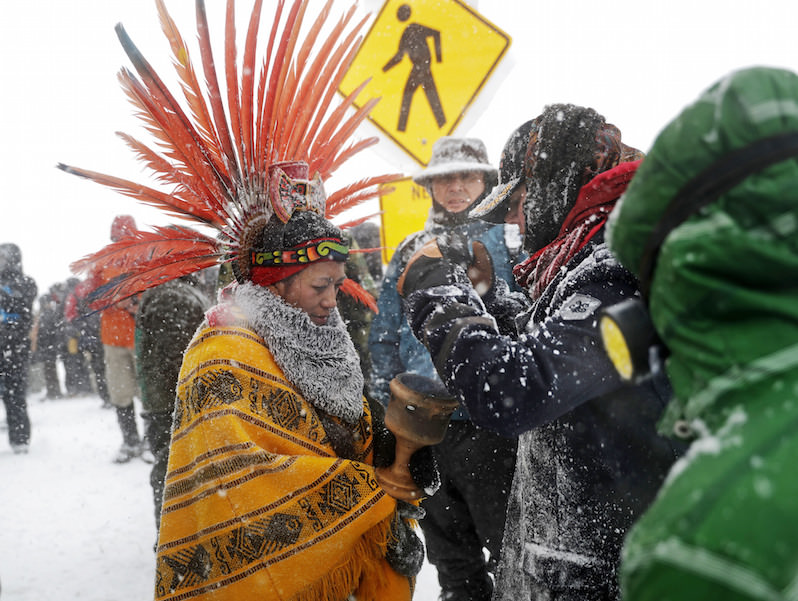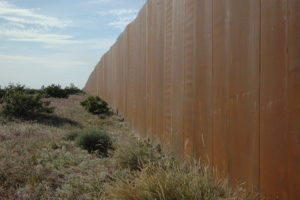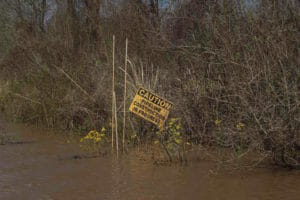What Are the Dakota Access Pipeline Builders Trying to Keep Secret?
An independent inspection is needed immediately to determine whether construction is continuing in defiance of an official order. Standing Rock water protectors are enduring harsh winter conditions in Cannon Ball, N.D., to oppose the Dakota Access oil pipeline. (David Goldman / AP)
Standing Rock water protectors are enduring harsh winter conditions in Cannon Ball, N.D., to oppose the Dakota Access oil pipeline. (David Goldman / AP)
Editor’s note: Four Arrows (aka Don Jacobs) is a professor at Fielding Graduate University, the author of 21 books, the former dean of education at Oglala Lakota College on the Pine Ridge Indian Reservation in South Dakota, a popular speaker and a Standing Rock water protector. The opinions and accounts expressed here are his own.
Why should it be so difficult to determine whether drilling is continuing on the Dakota Access pipeline in the face of an Army memorandum blocking such work? A finding must be made before more water protectors are hurt, and here are six reasons to quickly facilitate an on-site investigation by a credible inspection party.
1. The recent violence by National Guard troops and DAPL security militia against the water protectors still at Standing Rock — violence aimed at preventing those demonstrators from getting a view of building operations that were supposed to have ceased.
2. The continued closure of Highway 1806 on the Backwater Bridge.
3. The placement of an AN/TWQ-1 Avenger missile defense system. Although a North Dakota National Guard spokesman said the system is in place to serve in an “observation role,” the only purpose I can imagine for this would be to shoot down photographic drones.
4. A rational distrust of the Army Corps of Engineers—and the Army’s memorandum—by water protectors who have remained on the scene despite dangerously cold weather.
5. Public statements by Energy Transfer Partners (ETP, the company building the pipeline) and DAPL management that they would continue with the program regardless of the Army’s memorandum.
6. An analysis of a drone video of the east drill pad, concluding that pipe has been placed under the Missouri River from the east side.
1. The Recent Violence
On Monday, hundreds of water protectors participated in two actions throughout the day and night in freezing temperatures. One was near the west drill pad, where DAPL security, state police and Morton County Sheriff’s Department personnel were walking on Dakota graves. When the protectors arrived, the authorities lined up in full riot gear and holding large shields. Several feet away, on the other side of a coil of barbed wire, were the water protectors.
I watched two hours of a video covering the event.
Most of the action on the part of the protectors involved singing and praying. Some urged the police to “turn around and face the true enemy.” Shouting occurred here and there; some called the police cowards—for instance, when an officer used a stick to swat a person. One protector immediately reminded the person who was hit to be loving and not to provoke the police. However, another demonstrator cut the barbed wire and stepped across in defiance of those he believed had no right to be standing on his ancestors’ graves.
A participant described the water protectors’ action as being in honor of Martin Luther King Jr. Day and in solidarity with oppressed people everywhere.
There was a much larger group on the Missouri River side of the drill pad area, outside the concertina wire. It appeared that one man had crossed the wire and stood praying. The demonstrator was met by a phalanx of National Guard troops. Behind them, a North Dakota cop with a rifle positioned himself and shot the unarmed man in the forehead with a rubber bullet, just above the right eye.
The second action was at Backwater Bridge, near the main camp. The militia supporting DAPL shot plastic bullets and threw tear gas canisters at unarmed people who were standing, praying and singing. People were pushed back farther, past their side of the bridge.
In still another violent occurrence, a policeman ran over a water protector with a snowmobile. According to various reports, including a tweet from Linda Black Elk, the victim was taken to a hospital for emergency medical care.
Allegedly in response to the DAPL protests, several North Dakota state legislators introduced House Bill 1203 this week to make it “unlawful for a pedestrian to walk along and upon an adjacent roadway” and to give exemption from all liability if a motor vehicle driver kills a pedestrian.
My question is, why would DAPL security be guarding the drill pad area so aggressively if there were no concern about water protectors slowing down work that supposedly isn’t taking place?
2. Continued Closure of Highway 1806 on Backwater Bridge
The Backwater Bridge has been closed since October when vehicles were set on fire during an encounter between demonstrators and law enforcement. On Dec. 20, Dave Archambault, chair of the Standing Rock Sioux tribe, and North Dakota Gov. Doug Burgum discussed the importance of opening the bridge, agreeing to have core samples drawn immediately to determine its structural safety. Archambault does not believe that the bridge was closed for safety purposes, as authorities have claimed.
Virginia Polytechnic Institute conducted a major study on whether fires on concrete bridges could significantly endanger them and found that such damage would be nearly impossible.
On Jan. 5, at the monthly Standing Rock Tribal Council meeting, the bridge closure was a major topic. The issues it poses are significant to members of the Standing Rock community and the water protectors, who must take a long and treacherous detour to Mandan or Bismarck.
From a psychological warfare perspective, there could be many reasons DAPL continues to keep the bridge closed, but might the closure be about preventing scrutiny of what is happening on the east side of the river?
3. Anti-Drone Missile System
One of the water protectors at Standing Rock managed to get close-up video footage of a new object on the hill overlooking the main camp. Published Monday on Underground World News, images reveal what appears to be an AN/TWQ-1 Avenger, developed for the Army.
According to Wikipedia, the Avenger is “a self-propelled surface-to-air missile system weapon which provides mobile, short-range air defense protection for ground units” and has a range of 10 to 20 miles. In 2014, Tyler Rogoway, a writer who helped develop the defense-oriented website Foxtrot Alpha and the current editor of The War Zone (a Time Inc. publication), wrote an essay about Avenger units becoming “a commonplace fixture in and around Washington, D.C.,” and addressed the potential hazards to citizens.
Why would DAPL security require air defense? The only reason I can think of is to protect against the camera-carrying drones the water protectors have been using. Police have been shooting at the drones from the beginning, with one officer explaining that this was necessary to protect the helicopters flying over the main camp day and night. What could DAPL authorities be doing that they do not want photographed?
4. Distrust of the Army Corps of Engineers
Wesley Clark Jr. is responsible for having brought thousands of military veterans to Standing Rock to support the water protectors, and the presence of those veterans may have played a role in the Army’s decision to deny a permit for the pipeline to cross the river and for its requiring an environmental impact statement. On Monday, Clark told me he had a contact with the Army Corps of Engineers (ACE) who informed him that the corps is monitoring conditions at Standing Rock and that its “sensors” indicate no drilling is taking place.
I told him that many people, including me, have little trust in the corps, for good reasons. For example, consider ACE’s role in the flooding of the Missouri Valley in the 1950s. According to a 1997 peer-reviewed article by Robert Kelley Schneiders of Texas Tech University, officials of ACE and other government agencies ramrodded through dam site location and design in ways to favor farmers, with no regard for the Standing Rock Indians. The author describes how ACE built the dams on Indian treaty lands to protect major urban centers from the inundation that tribal lands suffered. The resultant flooding forced a fourth of the reservation population to relocate. Schneiders writes that—in ways similar to what’s taking place now—the Standing Rock tribe intensely resisted the efforts of ACE when it began construction of Oahe Dam in South Dakota, fearing they would lose their prime agricultural lands. ACE ignored this concern and broke treaties to continue.
Native Americans have a number of other historical reasons for not trusting ACE in addition to their long abuse at the hands of the government. For example, in resisting ACE’s destruction of the Gila Bend Indian Reservation, the Tohono O’odham Nation could win only a small victory in 1992. Add to this the way ACE in the current dispute allowed the relocation of the DAPL pipeline and engaged in the illegal activities that Bobby Kennedy Jr. describes so well.Trusting ACE without a careful investigation of the work areas in the Standing Rock vicinity would not be warranted. Is it possible that ACE is still working on behalf of DAPL and against the Standing Rock Sioux and the international movement opposing the pipeline?
5. Public Statements from ETP and DAPL Rejecting the Army’s Order
Immediately after the official memorandum that supposedly stopped progress of the pipeline and put in place a requirement for an environmental impact statement, Energy Transfer Partners and Sunoco Logistics Partners responded with a press release saying they remain “fully committed to complete the pipeline without any additional rerouting. …” They claim they followed “all legal requirements” and say “nothing this [Obama] Administration has done today changes that in any way. … The Army Corps of Engineers agrees and has said so publicly and in federal court filings. … The White House’s directive today to the Corps for further delay is just the latest in a series of overt and transparent political actions by an administration which has abandoned the rule of law in favor of currying favor with a narrow and extreme political constituency.”
I have a personal reason for thinking these words are not just angry rhetoric. A few days before my first trip to Standing Rock in September, the U.S. Court of Appeals ordered DAPL builders to lay no pipe within 20 miles of either side of the river until court filings from Standing Rock were considered. At a Veterans for Peace meeting I attended one night, a Standing Rock elder described having seen lights moving close to the river on the east side for several nights. The next day, I drove to the area on the other side of the river and searched for—and found—evidence of pipe-laying activity near the river. I returned and told what I saw to all, including the camp attorney, who said we needed to catch them in the act. I then chartered an airplane to fly over the site with a camera, but before the flight the U.S. Court of Appeals surprised everyone by withdrawing the 20-mile restriction. I wrote about this in a Truthout article, but my photos of the pipeline, including one of a section of pipe that was not buried and had a date on it, were not published due to quality issues.
Democracy Now! reported on Wednesday that water protectors scored another legal victory as a federal judge rejected the Energy Transfer Partners’ bid “to block the Army Corps of Engineers from beginning a lengthy environmental impact statement on the section of the pipeline slated to cross the Missouri River. The ruling means the environmental impact study will now move forward, indefinitely halting construction of the pipeline.”
Even so, in light of the public statement by the corporations in charge of DAPL, wouldn’t the Army want to assure compliance and ensure that pipeline building has not already gone under the river?
6. Analysis of a Drone Video
On Dec. 20, Digital Smoke Signals posted a seven-minute video entitled “East-West NODAPL Drill Pad.” Although I had no knowledge about the business of laying oil pipeline, I had an uncomfortable intuition. I sent the video to one of my Veterans for Peace colleagues, who said he had 30 years of experience in laying oil and gas pipeline. He immediately wrote back, saying, “Emergency. … The bastards are under the river! I’ll get back to you.” On Dec. 22, he sent several pages of analysis relating to a number of frames in the original video. I say “original,” because when I went back to YouTube to look at the video, it had been removed. There is a version still on YouTube, but according to my friend, who prefers to remain anonymous, it does not sufficiently show what he describes. Readers, however, can see the version on YouTube.
To give readers the tone of the analysis, which is quite technical, I include this excerpt:
Now, go to 1:24~ The red & white “Mud Reclaimer” is pointing towards the EAST wall of the Drill Box. Slightly to the right (in the South East corner [which would be the top, right in this frame] you’ll see the 80 degree down slope, that turns again, with the 120 degree “elbow” which makes the laid pipe lay flat on the ground, headed WEST. The fact that the brown pipe, and the green elbow have gone all the way to the lowest elevation in that excavation, then continued WEST for about 18 or 20 feet, means (drum roll) The “bore” (the passageway) for (A) the slim test bore, and (B) the reamed out (numerous times) 30+ inch bore hole has been expanded to a diameter (I.D.) big enough to PUSH the 30 inch diameter Pipe “juiced” with a bentonite slurry, clear under the river bed of the Missouri River, and back up, on the WEST shore (Morton County -Aceti Sakowin land on the N.D. Route 1806 side.)
I am not suggesting that the analysis of this video by one person “on our side” proves anything. Rather, someone has offered an opinion based on what appears to be knowledgeable observation that DAPL builders may have violated the Army’s order, and this can be added to other good reasons for demanding an official investigation and public report. For me, just knowing bentonite was on-site is telling. Bentonite is a classic “drilling mud,” injected to stabilize the bore hole and remove soil cuttings. If it is on the scene, this alone should warrant a visual investigation. Perhaps all the activities near the west drill pad have been a diversion.
I asked one of our volunteer lawyers if she would be willing to send the analysis, along with the original tape, to the main Standing Rock tribal attorneys. The lawyer was reluctant to do so after a friend of hers suggested it would have been impossible for DAPL builders to have drilled under the river without anyone knowing it, because they would have had to haul many rocks away. When I shared this with my pipeline authority, he sent me an explanation of why there would be no rocks. Here is a small part of what he said:
“LOSE IT” is the PipeLiner answer to “where do we put all the cuttings?” (that come out of the BoreHole)…The Drill Bit obliterates solid rock/stone/concrete etc., and turns it into a fine dust. The high pressure compressed air that rotates, or pushes, or pulls the Drill Bit also blows the dust & “mud” back, that is mixed (at the Drill Bit “head”) with a wet stream of slippery bentonite. When you look at the FAR right hand side of the EAST “Box” (or Drill Pad) R.O.W., you see a CAT D-7 Dozer, and a CAT Track Hoe, all the way down East, to the FAR Right. The Dozer pushes R.O.W. & cuttings mix, in pass after pass, out where the 330 or 335 HOE can swing his/her bucket back & forth, smoothing out the piles, into maybe a 3 or 4 inch “Lift”, for final “cover…” All the brown dirt area’s NORTH side boundary is bounded by the long piles of snow, dozed to the NORTH side of the R.O.W. (Right of Way)…etc.
* * *
I have offered six reasons, one for each sacred direction, for an official and appropriately staffed site visit to confirm whether DAPL builders have already drilled under the river. In light of the cost to citizens for the police and National Guard troops, and the potential for serious injuries to water protectors, this seems a small thing to ask, even if one does not see all my reasons as sufficient. One option for expressing an opinion is to call (202) 761-8700 and leave a message on the Standing Rock ACE phone.
But this is just a start. I know readers will have many other ideas for action, and I ask people to pass this article on to encourage an official site inspection. It may be that even if we show DAPL builders have violated federal law, the pro-oil allies of the new Trump administration may somehow manage to disregard the proof. One might hope, however, that our system of laws is still strong enough to prevent this.
Your support matters…Independent journalism is under threat and overshadowed by heavily funded mainstream media.
You can help level the playing field. Become a member.
Your tax-deductible contribution keeps us digging beneath the headlines to give you thought-provoking, investigative reporting and analysis that unearths what's really happening- without compromise.
Give today to support our courageous, independent journalists.





You need to be a supporter to comment.
There are currently no responses to this article.
Be the first to respond.